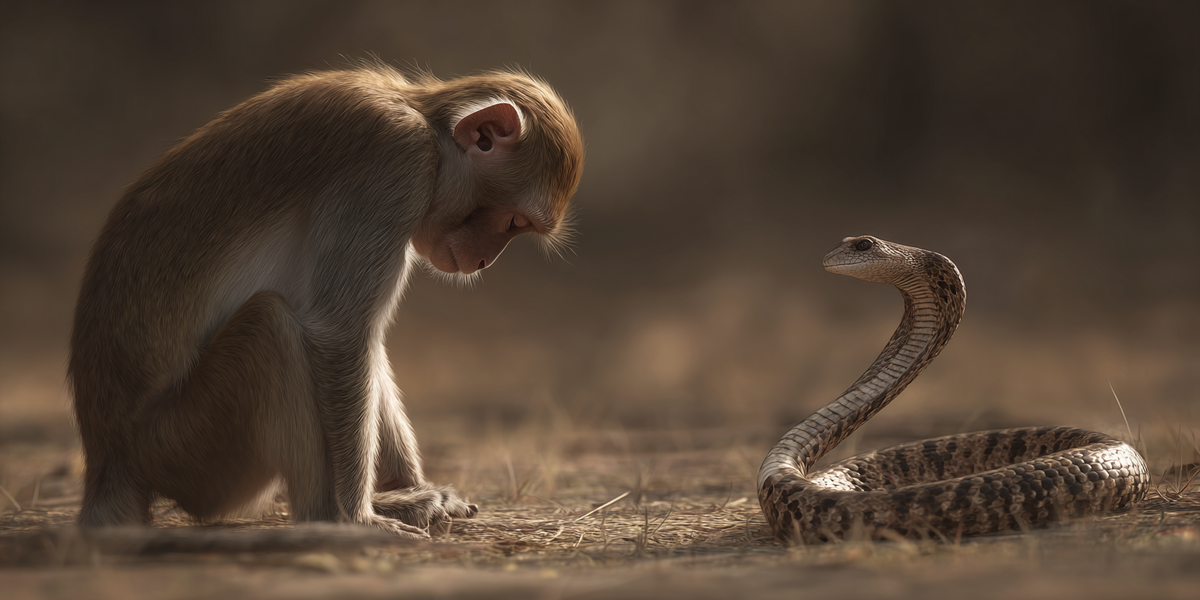A Curious Encounter
A short video clip circulates online: a monkey crouches low before a rearing king cobra, its head bowed until it nearly touches the ground. For a long moment, the tableau is frozen — the snake, hood flared, sways in the defensive pose for which cobras are famous, while the monkey remains with its head down, as if in reverence. Eventually the animal rises, reaches out with its hands, and begins to bat the serpent about almost playfully, tossing it from side to side as though it were a harmless rope. The cobra, astonishingly, does not strike.
At first glance, the scene appears almost ceremonial, like some spontaneous ritual between two creatures. Yet a closer, more realistic reading tells a different story. The cobra is almost certainly compromised — defanged, venom drained, or otherwise subdued, as is common in staged videos. Its passivity is not mystical tolerance but incapacity. The monkey’s initial posture, far from worship, is an instinctive act of defense. In the primate world, lowering the head and body is a way of shielding the throat and face, while simultaneously signaling submission: “I do not wish to fight.”
What fascinates here is not the theatricality of the staged cobra but the gesture of bowing itself. Stripped of mystical interpretation, it remains a powerful image — a small creature instinctively lowering itself before a figure it perceives as overwhelmingly dangerous. This single act provides a window into the deep roots of deference, a behavior shared by monkeys, humans, and ultimately enshrined in the most profound of human rituals.
The Ethology of Bowing
Ethology — the scientific study of animal behavior in natural settings — seeks to understand how creatures signal, submit, hunt, mate, and sustain social hierarchies. The term, drawn from the Greek ēthos (“character” or “habit”), was popularized in the twentieth century by figures such as Konrad Lorenz and Niko Tinbergen, who showed that animals possess instinctive repertoires of behavior shaped by evolution and survival.
Seen through this lens, what looks ceremonial often proves practical. Among primates, lowering the head is not a sign of reverence but of deference. By crouching and bowing, a monkey shields its most vulnerable parts — eyes, face, and throat — while displaying to a rival or predator that it does not intend to fight. The gesture conveys, without words: “I acknowledge your power; I submit.”
This survival grammar is not confined to monkeys. Wolves roll on their backs to expose their bellies to dominant pack members. Birds flatten their plumage or bow their heads before stronger rivals. Even reptiles and fish adopt postures that yield rather than provoke. Across species, the pattern is consistent: to lower oneself is to reduce threat and to reinforce order.
From this perspective, the monkey’s bow before the cobra is neither mystical nor random. It is the ancient code of survival written into the body, an instinctive act of submission in the face of overwhelming power.
From Animal Instinct to Human Ritual
Human beings inherit the same bodily signals as other primates, but we clothe them in culture. What begins as a reflexive gesture of deference — lowering the head, bending the body, averting the gaze — becomes formalized into ritual when transferred into human social life. In the earliest tribal and clan settings, crouching or bowing before a dominant figure helped preserve order just as it did among monkeys or wolves. But as human hierarchies grew more complex, the same posture took on new meaning.
Chieftains, warriors, and kings learned to demand outward signs of respect, and bowing became one of the most universal. To bow was to acknowledge authority, to admit dependence, to submit one’s own will to the greater power of the leader. What in animals had been a silent plea not to be harmed was in human society transformed into a visible confirmation of hierarchy.
Over time, this language of the body expanded beyond survival. In court etiquette, religious ceremonies, and diplomatic meetings, bowing codified not just submission but order, civility, and loyalty. The act became symbolic: lowering oneself was no longer only about avoiding danger, but about recognizing a structure larger than oneself — the authority of the chief, the command of the ruler, the cohesion of the group.
What had once been an instinctive posture of survival became a cultural ritual of allegiance. The same motion of bending low, inherited from animal reflex, became one of the foundational gestures of human civilization.
Kings Bow to Saints: A Higher Power Emerges
If bowing before rulers once embodied the pinnacle of human submission, an even more striking transformation occurred when kings themselves were seen bowing to figures outside the political order. In many cultures, the spectacle of a monarch humbling himself before a sage, prophet, or holy man reshaped public imagination. If even the one who wielded armies and law showed deference, then there must exist a power higher than the throne.
Myths and literature preserve this pattern. In the Arthurian cycle, Merlin’s authority as seer and guide precedes Arthur’s coronation, and without the wizard’s sanction the boy-king would remain a commoner. In Tolkien’s legendarium, Gandalf places the crown upon Aragorn’s head, symbolizing that spiritual wisdom outranks the sword. Indian traditions record Nārada Muni — a wandering sage who moves freely between heaven and earth — received with deference by kings and demons alike, his presence cutting across the lines of political power.
The imagery is consistent: worldly rulers, secure in their dominance, voluntarily bow to one whose authority is invisible yet undeniable. To ordinary people, the lesson is unmistakable. If kings yield to saints, then sanctity must be stronger than the sword. If kings bow to gurus, then wisdom and devotion must outrank the crown. The gesture of lowering oneself, once born of fear and later codified as respect, here becomes a declaration of a new hierarchy — the hierarchy of spirit over matter, of transcendence over temporal power.
Scriptural Paradigms of Submission
The pattern of rulers bowing to saints finds its highest expression in sacred history, where even divine incarnations themselves model humility. Scriptures across traditions preserve scenes in which the Lord, or His chosen representatives, submit to teachers and rituals as if to demonstrate that no one stands above the law of spiritual discipline.
In the Bhāgavata Purāṇa, Kṛṣṇa and Balarāma travel to the āśrama of Sandipani Muni. There they accept initiation and instruction, performing the duties of obedient disciples. Though Kṛṣṇa is acknowledged as the Supreme Lord, He places Himself beneath His guru to show by example how every human being must honor the chain of spiritual authority. Similarly, Śrī Caitanya, revered as an incarnation of divine love, receives initiation from Īśvara Purī, thereby sanctifying the principle of discipleship.
The Christian Gospels present a parallel in the baptism of Jesus by John in the Jordan River. John himself protests that he is unworthy, but Jesus insists on undergoing the rite, “to fulfill all righteousness.” In that act the Son of God bows to a human prophet, not from necessity but to teach others that humility and obedience are the gateway to spiritual life.
These episodes carry a consistent message: submission is not weakness, but alignment with a higher order. By bowing to their gurus or undergoing rites, the incarnations themselves establish the authority of tradition and the sanctity of humility. If the Lord bows, then surely His devotees must. The gesture of lowering oneself, born in animal instinct and carried through human hierarchy, finds here its divine confirmation — humility as the path to transcendence.
Anthropology Meets Theology
From one angle, the story of bowing can be read as a simple arc of cultural evolution. Ethologists explain how an instinctive survival posture in animals becomes formalized in human society as a gesture of hierarchy. Anthropologists then trace how this bodily code of submission extends from chiefs to kings, and eventually to priests, saints, and gurus. In this view, the bow is a product of human imagination — an instinctive reflex reshaped into a ritual of respect.
Yet the theological perspective offers a complementary narrative. Here, the same gesture is not merely the residue of evolutionary reflex but the instrument of divine pedagogy. The scriptures describe how God Himself, or His chosen agents, periodically descend to instruct humanity. They teach through example, showing that true greatness lies not in domination but in humility. Thus Kṛṣṇa bows to Sandipani Muni, and Jesus submits to baptism by John — not because they must, but because they wish to elevate humanity’s understanding of power.
Placed side by side, the two frameworks illuminate one another. Anthropology explains how the gesture arises and evolves; theology explains why it is transfigured into devotion. The first sees bowing as an inheritance of biology and culture, the second as the touch of revelation guiding that inheritance toward transcendence. What begins as an instinct of survival becomes, through divine intervention, an act of worship — the posture of the body raised into the posture of the soul.
The Gesture Transfigured
The scene of a monkey bowing before a cobra may seem like a curiosity, but it reveals something profound. The act of lowering oneself in the presence of overwhelming power is written deep into the animal body. It is at once defensive, deferential, and conciliatory — a posture that acknowledges the limits of one’s own strength. In human society, the same gesture became codified into rituals of hierarchy, respect, and allegiance. And when kings themselves bowed to saints, a new horizon opened: the recognition that spiritual authority surpasses the authority of the sword.
In the scriptural record, the story reaches its climax. Divine incarnations bow to human teachers, sanctifying humility as the highest law. What began as an instinct to survive became, through culture and revelation alike, a means of transcendence. The gesture of bowing, once the body’s plea for mercy, becomes the soul’s expression of love.
Thus the line runs unbroken: from the animal crouch before danger, to the subject bowing before a king, to the king bowing before a saint, and finally to humanity bowing before God. What the body first learned in fear, the spirit learns anew in devotion. The gesture remains the same, but its meaning is transfigured — no longer submission to force, but surrender to the source of all power.
om tat sat


Member discussion: